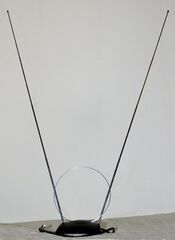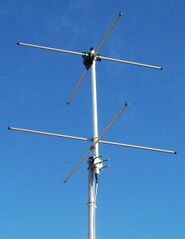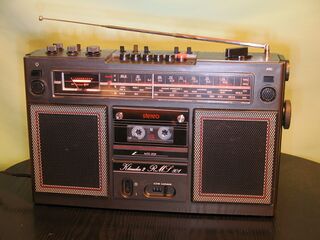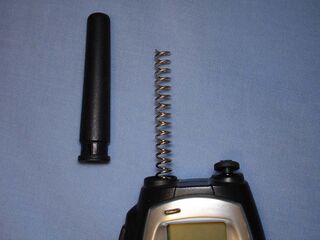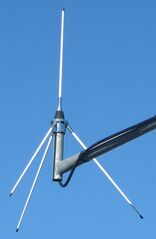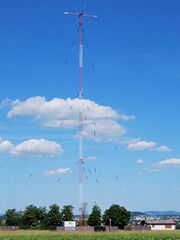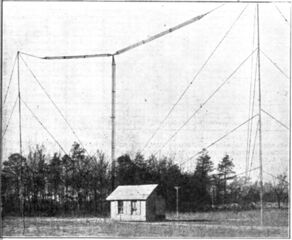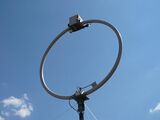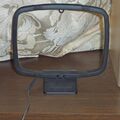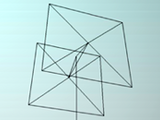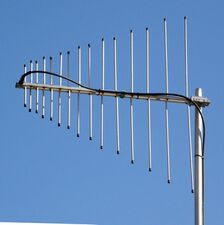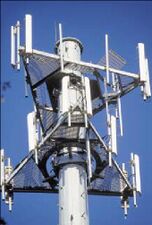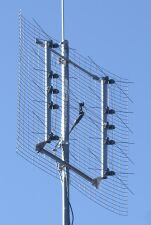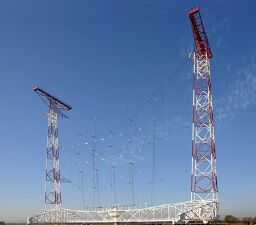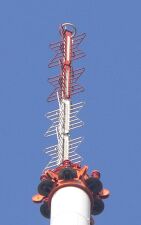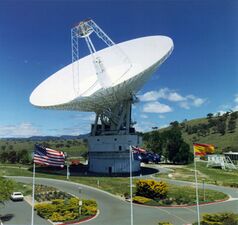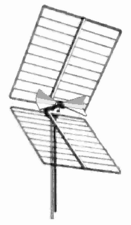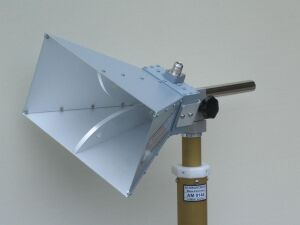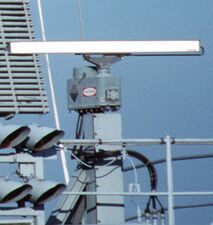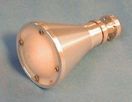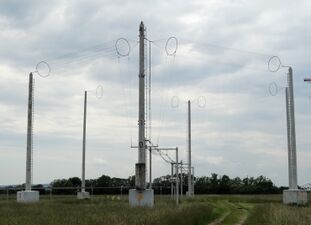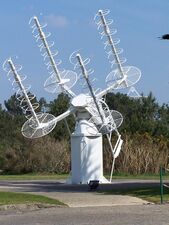Engineering:Antenna types
In radio systems, many different antenna types are used whose properties are especially crafted for particular applications. Antennas can be classified in various ways. The list below groups together antennas under common operating principles, following the way antennas are classified in many engineering textbooks.[1][2][3]:{{{1}}}
- The dipole, monopole, and large loop antenna types (simple antennas) discussed below typically function as resonant antennas; in resonant antennas, waves of current and voltage bounce back and forth between the ends, or circulate around a closed loop, and their overlapping sections add and subtract to form standing waves along the elements. These are sometimes further subdivided into linear antennas (dipoles, monopoles, etc.) and loop antennas (large loops, small loops, and halo antennas).
- Array and aperture antennas are both types of composite antennas. Array antennas are made out of combinations of several simple antennas that function as a single antenna. Aperture antennas made of an outer, surrounding reflective surface whose shape concentrates waves striking it onto a small inner simple antenna; the inner antenna can be either resonant or non-resonant.
- Traveling wave antennas are not resonant: Current and voltage waves induced by RF radiation travel through them in two directions along the antenna elements, but are delivered to the feedpoint only on one end; on the opposite end the waves raised by radio signals arriving from the opposite direction are absorbed a terminating resistor, to prevent the waves from being reflected to the feedpoint. The arrangement causes the resistor-terminated antenna to receive in only one direction.
Simple antennas
The category of simple antennas consists of dipoles, monopoles, and loop antennas, all of which can be made with a single section of wire (with some exceptions). Dipoles and monopoles called linear antennas (or straight wire antennas) since their radiating parts lie along a single straight line. On rare occasions they are called electric antennas since they engage with the electric part of RF radiation, in contrast to loops, which correspondingly are magnetic.
Dipoles
"Rabbit ears" dipole variant for VHF television reception
Two-element turnstile antenna for reception of weather satellite data, 137 MHz. Has circular polarization.
The dipole consists of two conductors, usually metal rods or wires, usually arranged symmetrically, end-to-end, with one side of the balanced feedline from the transmitter or receiver attached to each, and usually elevated as high as feasible above the ground.[2][lower-alpha 1] The most common type, the half-wave dipole, consists of two resonant elements just under a quarter wavelength long. This antenna radiates maximally in directions perpendicular to the antenna's axis, giving it a small directive gain of 2.15 dBi. Although half-wave dipoles are used alone as omnidirectional antennas, they are also a building block of many other more complicated directional antennas.
- Turnstile
- Two dipole antennas mounted at right angles, fed with a phase difference of 90°. This antenna is unusual in that it radiates in all directions (no nulls in the radiation pattern), with horizontal polarization in directions coplanar with the elements, circular polarization normal to that plane, and elliptical polarization in other directions. Used for receiving signals from satellites, as circular polarization is transmitted by many satellites.
- Patch (microstrip)
- A type of antenna with elements consisting of metal sheets mounted over a ground plane. Similar to dipole with gain of 6–9 dBi. Integrated into surfaces such as aircraft bodies. Their easy fabrication using PCB techniques have made them popular in modern wireless devices. Often combined into arrays.
- Biconical antenna
- A dipole with cone-shaped arms, with the feedpoint where their tips meet. They show broader bandwidth than ordinary dipoles, up to three octaves above their base frequency.
- Bow-tie antenna
- Also called a butterfly antenna – a dipole whose arms are triangular or arrow-shaped (⧓ ⨝ ⪥) with the feedpoint where the tips of the triangles meet. It is a flattened version of a biconical antenna. The triangles can either be cut from sheet metal with solid metal centers (⧓), or two wires with their far ends connected (⨝) outlining the shape of a bow-tie, or with unconnected ends in an "X" shape (⪥).[lower-alpha 2]
- Fan dipole
- Also called a multi-dipole – a common broadband and / or wideband dipole variant that superficially resembles the bow-tie antenna, but is electrically different. It is a composite of pairs of dipole arms; both arms of one of the dipoles are equal-length, but each dipole pair is a different length from every other pair. The several dipole arms extend away (⪫⪪ ⫸⫷) from the common central connection point of the combined antenna.[lower-alpha 3]
Monopoles
Quarter-wave whip antenna on an FM radio for 88–108 MHz
Rubber ducky antenna on 446 MHz UHF walkie-talkie with rubber cover removed.
Mast radiator antenna of medium wave AM radio station, Germany
'T' antenna of amateur radio station, 80 ft high, used at 1.5 MHz.
Folded unipole antenna with a solid metal mast surrounded by six skirt wires, held away by standoffs
A monopole antenna is a half-dipole (see above); it consists of a single conductor such as a metal rod, usually mounted over the ground or an artificial conducting surface (a so-called ground plane).[2][5] They are sometimes classed together with dipoles (see above) in the broader category of linear antennas, or more plainly straight wire antennas, since their radiating section is normally a straight (linear) wire or aluminum tubing; rarely, they are called electric antennas, since they interact with the RF electric field, to contrast them against loop antennas, which are correspondingly magnetic.
One side of the feedline from the receiver or transmitter is connected to the conductor, and the other side to ground or the artificial ground plane. The radio waves reflected from the ground plane appear as if they came from a fictitious image antenna seemingly below the ground plane, with the monopole and its phantom image effectively forming a dipole. Hence, the monopole antenna has a radiation pattern identical to the top half of the pattern of a similar dipole antenna, and a radiation efficiency a bit less than half of the dipole. Since all of the equivalent dipole's radiation is concentrated in a half-space, the antenna has twice (3 dB increase of) the gain of a similar dipole, neglecting power lost in the ground plane.
The most common form is the quarter-wave monopole which is one-quarter of a wavelength long and has a gain of 5.12 dBi when mounted over a ground plane. Single monopoles have an omnidirectional radiation pattern, so they are used for broad coverage of an area, and have vertical polarization. To reduce signal absorption by the Earth, ground waves used for broadcasting at low frequencies must be vertically polarized, so large vertical monopole antennas are used for broadcasting in the MF, LF, and VLF bands. Small monopoles ("whips") are used as nondirectional antennas on portable radios in the HF, VHF, and UHF bands.
- Whip
- Type of antenna used on mobile and portable radios in the VHF and UHF bands such as FM "boom boxes", consists of a flexible rod, often made of telescoping segments. In the HF band, "whip" typically refers to an antenna that is too short to resonate naturally; when a whip is long enough to self-resonate (a quarter wavelength or more), it is instead usually just called by the generic name "monopole".
- "Rubber ducky"
- More formal technical name is normal-mode helix. Most common antenna used on portable two-way radios and cordless phones due to its compactness. Consists of an electrically short wire helix. The helical shape adds inductance to cancel the capacitive reactance of the short radiator, making it resonant. Like all electrically short antennas it is nearly isotropic – has very low gain. Not to be confused with the much larger axial mode helix (see below).[lower-alpha 4]
- Ground plane antenna
- A whip antenna with several rods extending horizontally from base of the whip, attached to the ground side of the feedline. Since the whip is mounted above ground, the horizontal rods form an elevated ground plane just below the whip to reflect its radiation away from the earth and increase its gain. Used for elevated base station antennas for land mobile radio systems such as police, ambulance, and taxi dispatchers.
- Mast radiator
- A radio tower in which the tower structure itself serves as the antenna. Common form of transmitting antenna for AM radio stations and other MF and LF transmitters. At its base the tower is usually, but not necessarily, mounted on a ceramic insulator to isolate it from the ground.
- Folded unipole antenna
- A modified mast antenna, usually grounded at its base, augmented by one or several parallel wires called "skirt wires" that attach to the mast part-way up the antenna. The skirt wires can attach at any height between part-way up and the top of the mast. One or more of the skirt wires is fed with the signal, similar to a gamma match. The number and relative thickness of the mast and the skirt wires adjusts the feedpoint impedance.[lower-alpha 5]
- 'T' antenna
- Consists of a long horizontal wire suspended between two towers with insulators, with a vertical wire hanging down from it, attached to a feedline to the receiver or transmitter on one feed wire and the other to a required low resistance ground. The dangling vertical wire is the radiating part of the antenna; normally it is shorter than the quarter wavelength required for resonance. For the 'T' antenna, the dangling wire attaches in the exact center of the top wire. Used on LF and VLF bands. Since at these frequencies the vertical wire is electrically short – much shorter than a quarter wavelength – the horizontal wire serves as a "capacitance hat" to increase the current in the vertical radiator, increasing the efficiency and gain. Since equal horizontal currents travel in opposite directions away from the center of the top wire, those currents balance and produce essentially no radiation. Usually the horizontal section is not long enough to supply sufficient capacitance, so the antenna feedpoint requires a loading coil to tune out any remaining reactance, and the tuned antenna will have narrow bandwidth. When the "capacitance hat" is wide enough to compensate for the missing length on the vertical wire, a 'T' antenna's performance can come close to a full-size monopole.
- Inverted 'L'
- Similar in construction to a 'T' antenna described above, but with the dangling vertical wire attached to one end of the horizontal wire instead of the center. The altered connection point gives the antenna the shape of the Greek letter Γ. Unlike the 'T' antenna, both the vertical and horizontal wires radiate, with their respective radiation being vertically and horizontally polarized, and their combined radiation diagonally polarized, usually at a steep angle. Although all parts of the antenna radiate, the strongest radiation comes from the vertical wire, so the horizontal wire serves both as a "capacitance hat" and as a weak radiator. If the length of the horizontal wire is sufficient to make the total length of wire about a quarter wavelength, the inverted-L's performance can come close to a full-size monopole.
- Inverted 'F'
- Combines the advantages of the compactness of inverted-L antenna, and the good matching of the unipole antenna. The antenna is grounded at the base and fed at some intermediate point. The position of the feed point determines the antenna impedance. Thus, matching can be achieved without the need for a separate matching network. Effectively a shunt-fed inverted-L, with the feed point attached to the horizontal wire rather than the vertical, giving the antenna the shape of the line-drawing character ╓, or the Hangul letter ᄁ.
- Umbrella
- Very large wire transmitting antenna with extremely narrow bandwidth, used on VLF bands for VLF time signals or long-range submarine communications; relative to the even larger wavelengths it is used for, it is paradoxically an ultra-short antenna. An elaborated and enlarged version of a 'T' antenna. It consists of a central radiating tower with multiple wires attached at the top, extending out radially from the mast and insulated at the ends, resembling a metal umbrella frame. Like other ultra-short antennas it has an extremely high capacitive reactance and minimal radiation resistance, which require a large loading coil and low-resistance counterpoise system.
Loop antennas
Loop antennas consist of a loop (or coil) of wire. Loop antennas interact directly with the magnetic field of the radio wave, rather than its electric field as linear antennas do; for that reason they are on rare occasions categorized as magnetic antennas, but that generic name is confusingly similar to the term magnetic loop used to describe small loops. Their exclusive interaction with the magnetic field makes them relatively insensitive to electrical noise within about 1/ 6 wavelength of the antenna.[2][6][7] There are essentially two broad categories of loop antennas: large loops (or full-wave loops) and small loops. Only one design, a halo antenna, that is normally called a loop does not clearly fit exclusively into either the large or small loop categories.
Large loops
Full-wave loops have the highest radiation resistance, and hence the highest efficiency of all antennas: Their radiation resistances are several hundreds of Ohms, whereas dipoles and monopoles are tens of Ohms, and small loops and short whip antennas are a few ohms, or even fractions of an Ohm.[7]
- Large loops
- Large loops have a perimeter of one full wavelength, or larger. When they are one, two, or three wavelengths, or any whole-number multiple of a wavelength, they are naturally resonant and act somewhat similarly to the full-wave or multi-wave dipole. When it is necessary to distinguish them from small loops, they are called "full-wave" loops.[lower-alpha 6][2][6]
- Quad
- Although "quad" can refer to a single quadrilateral-shaped loop, the term usually refers to two or more loops stacked side by side; at first glance, quads resemble a box kite frame. Only one of the loops in the quad is connected to the feedline, and that loop functions as the driver for the antenna and is the main signal radiator. The other loops are parasitic elements that act as reflectors or directors, focusing the radiated waves in a narrower, single direction and thereby increasing the gain.[2][6][7] Quad antennas are Yagi-Uda antennas made from loops instead of dipoles or monopoles,[2][6][7] and are likewise used as a directional antennas on the HF bands for shortwave communication. They are sometimes preferred for longer wavelengths because (if square) they are half as wide as a Yagi built from dipoles.[2][6][7]
- Half-loop
- the upper half of a vertical full-wavelength loop antenna mounted on the ground (not to be confused with the somewhat similar half-square antenna described above).[lower-alpha 7] The full loop is cut at two opposite points along its perimeter, and the lower half is omitted; the upper half mounted on the ground at the cut points, sticking up from the ground like a satchel handle. It is shaped like the Greek letter Π or an upside-down capital letter U, and is the loop antenna analog of a ground-mounted monopole antenna. Like a vertical monopole, the missing lower half of the antenna is replaced by its ground-plane image. If shaped like a half of a square, a half-loop can operate either as a loop antenna or on its first harmonic, depending on the position of its feed-point, as a dipole antenna whose ends have been bent over and grounded.[8]
In between
- Halo antennas
- Loops one half-wavelength in perimeter, that have a small gap cut in the loop, are called "halos". They are naturally resonant on one frequency, and are intermediate in size and function between small and large loops. They are often described as a half-wavelength dipole that has been folded into a circle, rather than being a "true loop" antenna.[2][6][7][3]:{{{1}}}
The approximately-omnidirectional pattern of halos resembles small loops; their radiation efficiency lies inbetween the extremely high efficiency of large loops and the generally poor efficiency of small loops. Halos are self-resonant like full-wave loops, but have no useable higher harmonics. In some regards they represent the extreme upper size limit of small transmitting loops.[2][7][3]:{{{1}}}
Small loops
Small loop antennas have very low radiation resistance – typically much smaller than the loss resistance of the wire they are made of, making them inefficient for transmitting. Their directionality and low radiation efficiency is drastically different from full-wave loops, and if the loop perimeter is smaller than a half-wavelength, if resonance is necessary the loop must be modified in some way to make it resonant. Despite their drawbacks, small loops are widely used as receiving antennas, especially at lower frequencies, where their efficiency is a non-issue and their small size makes them a useful solution to the excessive sizes of even quarter-wave antennas. The fact that they can be efficiently tuned to accept only a very narrow frequency range helps ease much of the trouble with pervasive static on the mediumwaves. Small loops are called "magnetic loops", and if modified for resonance they are also called "tuned loops".
- Small receiving loops
- Small receiving loops are sized at 1 /4~ 1 /10 wave perimeters, sometimes with many turns of wire around the same supporting frame. Small loops are widely used as compact direction finding antennas, since their "null" direction is exceptionally precise, and their small size makes them much more compact as hand-carried equipment than dipole-based directional antennas.[2][6][7]
- Ferrite loop antennas
- Also called "loopsticks", they consist of a wire coiled around a cylindrical ferrite core (the "stick"). The ferrite increases the coil's inductance hundreds to thousands of times larger, and likewise magnifies its effective signal-capturing area. The improvement makes them even more compact than ordinary small loops (those without ferrite) with equivalent performance. Loopsticks' radiation pattern is identical to a dipole antenna, with a maximum in all directions perpendicular to the ferrite rod. These are used as the receiving antenna in most portable and desktop consumer AM radios made for the medium wave broadcast band, and for lower frequencies.[lower-alpha 8]
- Small transmitting loops
- Small transmitting loops are loop antennas whose perimeters are smaller than a half-wave, that have been specifically optimized for transmitting. Their much smaller size than dipole antennas (only ~10% as wide) sometimes makes them a viable choice, despite their lower efficiency. Small transmitting loops are made larger in size than most small receiving loops, with perimeters near 1 /3~ 1 /4 wave,[lower-alpha 9] in order to improve on their generally poor efficiency. For that same reason, their parts are carefully joined by brazing or welding to reduce losses from resistance. Because of their larger size, small transmitting loops lack the sharp nulls of small receiving loops, so they are not as useful for direction finding, and also are more bulky (roughly double the size) so would not be as convenient as small loops for hand-held use in radio searches.[7]
The nulls in the radiation pattern of small receiving loops and ferrite core antennas are bi-directional, and are much sharper than the directions of maximum power of either loop or of linear antennas, and even most beam antennas; the null directionality of small loops is comparable to the maximal directionality of large dish antennas (aperture antennas, see below).[citation needed] This makes the direction of the small receiving loop's null much more precise than the direction of the strongest signal for accurately locating a signal source, and the small loop / ferrite core type antennas are useful for radio direction finding (RDF). The null direction of small loops can also be exploited to exclude unwanted signals from an interfering station or noise source.[2][6][7] Several construction techniques are used to ensure that small receiving loops' null directions are "sharp", including making the perimeter 1 /10 wavelength, or at most 1 /4 wavelength. Small transmitting loops' perimeters are instead made as large as feasibly possible, up to 1 /3 wave, or even 1 /2 if possible, in order to improve their generally poor efficiency.
Composite antennas
Array
VHF collinear array of folded dipoles
Yagi–Uda television antenna for analog channels 2–4, 47–68 MHz
Sector antennas (white bars) on cell phone tower. Collinear arrays of dipoles, these radiate a flat, fan-shaped beam.
Reflective array UHF TV antenna, with bowtie dipoles to cover the UHF 470–890 MHz band
US Air Force PAVE PAWS phased array radar antenna for ballistic missile detection, Alaska. The two circular arrays are each composed of 2677 crossed dipole antennas.
Curtain array shortwave transmitting antenna, Austria. Wire dipoles suspended between towers.
Array antennas are composites of multiple simple antennas, either linear, or loops, or combinations of each. The multiple parallel-aligned simple antennas work together as a single compound antenna; they are the RF analogs of compound optical lenses made from combinations of simple lenses. The constituent simple antennas can be dipoles, monopoles, or loops, or mixed loops and dipoles. Broadside arrays consist of multiple identical driven elements, usually dipoles, fed in phase, radiating a beam perpendicular to the plane containing the simple antennas. Endfire arrays are fed out-of-phase, with the phase difference corresponding to the distance between them; they radiate parallel to the plane that the consitituent antennas all lie in.[2][9][3]:{{{1}}} Parasitic arrays consist of multiple antennas, usually dipoles, with one driven element and the rest parasitic elements, which radiate a beam along the line of the antennas.
- Vertical collinear
- Consists of several dipoles fed in phase, with their axēs stacked atop each other, in a single vertical line. It is a high-gain omnidirectional antenna, meaning more of the power is radiated in horizontal directions and less wasted radiating up into the sky or down onto the ground. Gain of 8–10 dBi. Used as base station antennas for land mobile radio systems such as police, fire, ambulance, and taxi dispatchers, and sector antennas for cellular base stations.
- Yagi–Uda
- Also called a "Yagi", it is one of the most common directional antennas at UHF, VHF, and upper HF frequencies. Consists of multiple half-wave dipole elements aligned with their axēs parallel, in the same plane, with a single resonant-length driven element wired to the feedline, usually the next-to-last, next-to-longest element in the array.[lower-alpha 10] The multiple other elements are parasitic, which reflect and direct the radiated signal into a single direction, hence a beam antenna.[lower-alpha 11]
- Yagi–Udas are used for rooftop television antennas, point-to-point communication links, and long distance shortwave communication using skywave ("skip") reflection from the ionosphere. They typically have gains between 10–20 dBi depending on the number of director elements used, but their bandwidths are very narrow.[lower-alpha 12]
- Moxon antenna
- Also called a Moxon rectangle; it is a rectangular-shaped, folded version of a two-element Yagi-Uda.[10]
- Adcock antenna
- An array of four parallel dipole (or monopole) antennas, all equal size and equidistant, aligned vertically at four corners of a square. All four dipoles are driven, but with opposing phases for adjacent dipole elements. The spacing and phasing of the dipole elements makes the combination of the arrayed elements moderately directional.
- Log-periodic dipole array
- Sometimes called a "fishbone" antenna. It consists of many dipole elements along a boom with gradually increasing lengths, all connected to the transmission line with alternating polarity. It is a directional antenna with a wide bandwidth, which makes it ideal for use as a rooftop television antenna, although its gain is much less than a Yagi of comparable size.[lower-alpha 10] For long wavelengths in the lower HF band the array may be made of ground-mounted monopoles instead of dipoles.
- Reflective array
- Multiple dipoles in a two-dimensional array mounted in front of a flat reflecting screen. Used for radar and UHF television transmitting and receiving antennas.
- Phased array
- is a high gain antenna used at UHF and microwave frequencies which is electronically steerable. It consists of multiple dipoles in a two-dimensional array, each fed through an electronic phase shifter, with the phase shifters controlled by a computer control system. The beam can be instantly pointed in any direction over a wide angle in front of the antenna. Used for military radar and jamming systems.
- Curtain array
- is a large directional wire transmitting antenna used at HF by shortwave broadcasting stations. It consists of a vertical rectangular array of identical wire dipoles suspended in a parallel row in front of a flat reflector screen, consisting of a second row of vertical parallel "curtain" wires, all supported between two metal towers. It radiates a horizontal beam of radio waves into the sky above the horizon, which is reflected by the ionosphere to Earth beyond the horizon.
- Half-square
- A pair of quarter-wave inverted vertical monopoles, whose bases are not connected to the ground, and whose tops are connected by a wire one half-wavelength long, which serves as both a counterpoise and a crossover feedline. The verticals are the radiators and function as a two-element array, similar to the bobtail curtain; each radiator's nominal feedpoint is at its top, rather than at the base. The structure is shaped like the Greek letter Π (not to be confused with the Half-Loop antenna described below).[lower-alpha 7] The top-to-top connecting wire serves as a phased feedline, or an auxiliary feed, which puts the point of maximum current at the top of each monopole. Neither monopole element has a wire connection to the ground beneath it, although there typically is considerable capacitive coupling, which can be exploited to shorten the verticals. Top-fed inverted monopoles produce a strong signal lower to the horizon than an ordinary bottom-fed monopole, since the latter's signal must angle up more from ground-level to get past nearby obstructions. Despite the verticals themselves being fed from their tops, the feedpoint for the combined system may be placed at any of several locations – often at the center of the horizontal wire.[8]
- Batwing
- Also called a superturnstile, is a specialized antenna used in television broadcasting consisting of perpendicular pairs of dipoles with radiators resembling bat wings. The batwing shape gives them the wide bandwidth needed for whole-channel transmission. Typically several batwing antennas are stacked vertically on a mast to make VHF television broadcast antennas. Omnidirectional radiation pattern with high gain in horizontal directions.
- Microstrip
- A microwave antenna that can achieve large gains in compact space; an array of patch antennas on a substrate fed by microstrip feedlines. Ease of fabrication by PCB techniques have made them popular in modern wireless devices. Beamwidth and polarization can be actively reconfigurable.
Aperture
NASA Cassegrain, Extremely high gain ~70 dBi.
Corner reflector UHF TV antenna with "bowtie" dipole driven element at its center.
Microwave horn antenna bandwidth 0.8–18 GHz.
X band marine radar slot antenna on ship, 8–12 GHz.
An aperture antenna consists of a small dipole or loop feed antenna embedded inside a larger, three-dimensional surrounding structure that guides the radio waves from the feed antenna in a particular direction, and vice versa. The guiding structure is often dish-shaped or funnel-shaped, and quite large compared to a wavelength, with an opening, or aperture, to emit the radio waves in only one direction. Since the outer antenna structure is itself not resonant, it can be used for a wide range of frequencies, by replacing or retuning the inner feed antenna, which normally is resonant.
- Corner reflector
- A directive antenna with moderate gain of about 8 dBi often used at UHF frequencies. Consists of a dipole mounted in front of two reflective metal screens joined at an angle, usually 90°. Used as a rooftop UHF television antenna and for point-to-point data links.
- Parabolic
- The most widely used high gain antenna at microwave frequencies and above. Consists of a dish-shaped metal parabolic reflector with a feed antenna at the focus. It can have some of the highest gains of any antenna type, up to 60 dBi, but the dish must be large compared to a wavelength. Used for radar antennas, point-to-point data links, satellite communication, and radio telescopes.
- Horn
- A horn antenna has a flaring metal horn attached to a waveguide. It is a simple antenna with moderate gain of 15 to 25 dBi, used for applications such as radar guns, radiometers, and as feed antennas for parabolic dishes.
- Slot
- Consists of a waveguide with one or more slots cut in it to emit the microwaves. Linear slot antennas emit narrow fan-shaped beams. Used as UHF broadcast antennas and marine radar antennas.
- Lens
- A lens antenna is made from a layer of dielectric, or a metal screen, or multiple waveguide structure of varying thickness, in front of a feed antenna, which acts as a lens which refracts the radio waves, focusing them on the feed antenna.
- Dielectric resonator
- Consists of small ball or puck-shaped piece of dielectric material excited by aperture in waveguide Used at millimeter wave frequencies
Traveling wave
Quadrant antenna, similar to rhombic, at an Austrian shortwave broadcast station. Radiates horizontal beam at 5-9 MHz, 100 kW
Array of four axial-mode helical antennas used for satellite tracking, France
Unlike the antennas discussed so-far, traveling-wave antennas are not resonant so they have inherently broad bandwidth.[2][3]:{{{1}}} They are typically wire antennas that are multiple wavelengths long, through which the voltage and current waves travel in one direction, instead of bouncing back and forth to form standing waves as in resonant antennas. All except the helical antenna have linear polarization. Unidirectional traveling-wave antennas are terminated by a resistor at one end, with the resistor's "Ohmage" equal to the antenna's characteristic impedance, in order to maximally absorb the waves traveling toward that end, with almost no unwanted signals reflected back to the feedpoint. The terminating resistor absorbs the waves traveling along the wire towards the resistor, which causes the antenna to only receive waves traveling in the opposite direction, away from the resistor and toward the feedpoint at the opposite end. This makes traveling-wave antennas inefficient transmitting antennas, but when used for receiving removes half of the incident radio noise while preserving the desired signal.
- Beverage
- Simplest unidirectional traveling-wave antenna. Consists of a straight wire one to several wavelengths long, suspended near the ground, connected to the receiver at one end and terminated at the other end by a resistor equal to its characteristic impedance (typically 400~800 Ω). Its radiation pattern has a main lobe at a shallow angle in the sky off the terminated end. It is used for reception of skywaves reflected off the ionosphere in long distance "skip" shortwave communication.
- Rhombic
- Consists of four equal wire sections shaped like a rhombus. It is fed by a balanced feedline at one of the acute corners, and the two sides are connected to a resistor equal to the characteristic resistance of the antenna at the other. It has a main lobe in a horizontal direction off the terminated end of the rhombus. Used for skywave communication on shortwave bands.
- Leaky wave
- Microwave antennas consisting of a waveguide or coaxial cable with a slot or apertures cut in it so it radiates continuously along its length.
- Axial mode helix
- Consists of a wire in the shape of a helix mounted above a reflecting screen, whose total coiled length is on the order of at least one wavelength. It radiates circularly polarized waves in a beam out of the open end of the helix, with a typical gain of 15 dBi. It is used at VHF and UHF frequencies where antenna sizes are feasible. Often used for satellite communication, which uses circular polarization because it is insensitive to the relative rotation on the beam axis.[lower-alpha 13] Not to be confused with a "rubber ducky" antenna (normal mode helix), which is much smaller.[lower-alpha 4]
Isotropic
An isotropic antenna (isotropic radiator) is a hypothetical antenna that radiates equal signal power in all directions. An old-fashioned incandescent light bulb is often described as an example of a nearly isotropic radiator (of heat and light). Paradoxically, every antenna of any type, shorter than ~ 1 /10 wave in its longest dimension, is isotropic (roughly), but no real antenna can ever be isotropic (exactly).
An antenna that is exactly isotropic is only a mathematical model, used as the base of comparison to calculate the directionality or gain of real antennas. No real antenna can produce a perfectly isotropic radiation pattern, but the isotropic radiation pattern serves as a "worst case" reference for comparing the degree to which other antennas, regardless of type, can project radiation in one direction.
All simple antennas approach closer and closer to being isotropic, as the waves they are transmitting or receiving increase in length beyond several times the antennas' longest side. Nearly isotropic antennas can be made by combining several small antennas. Nearly isotropic antennas are used for field strength measurements, as standard reference antennas for testing other antennas, and as emergency antennas on satellites, since they work even if the satellite has lost its orientation to its communication station.
Isotropic antennas, which don't actually exist, should not be confused with omnidirectional antennas, which are fairly common. An isotropic antenna radiates equal power in all three dimensions, while an omnidirectional antenna radiates equal power in all horizontal directions, but little or none vertically. An omnidirectional antenna's radiated power varies with elevation angle: Maximum in the horizontal, and diminishing as the direction rises to be parallel to the antenna's vertical axis of symmetry. Several antenna types do not radiate at all in the exactly vertical direction, even as wavelength increases, as opposed to an isotropic antenna, which radiates equally in every direction.
Other antenna types
- Snake antenna
- Random wire antennas laid out on the surface of the ground are called "snake antennas", which are not clearly distinguished as any particular type.
- B.O.G. antenna
- A "Beverage on the ground" – often called a "B.O.G." or bog antenna – is a "snake antenna" laid in a straight line that has its end opposite the feedpoint grounded. It is a travelling wave antenna, and is technically an extreme instance of a low-hanging Beverage antenna.
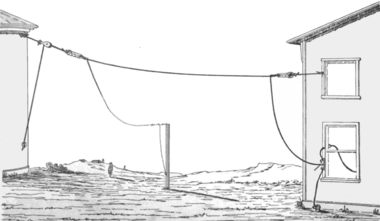
- Random wire antenna
- A random wire is the typical informal antenna erected for receiving shortwave and AM radio. It consists of a random length of wire either strung outdoors between elevated supports, or indoors across a ceiling, running in an erratic zigzag pattern along walls or between supports. One end of the wire is connected to the receiver. Moxon (1993) described it as "the odd bit of wire".<ref name=Moxon-1993>
Moxon, Les A. (G6XN) (1993). HF Antennas for All Locations (2 ed.). Radio Society of Great Britain. ISBN 1-872309-15-1.
The shape and length of a "random" wire is determined by the available space, locations and number of possible elevated attachment points, and how far the total available length of wire can reach. It is not laid out in a single straight line in a planned direction, and is generally is not trimmed to any particular (resonant) length. A random wire antenna typically has a complicated radiation pattern, with several lobes at varying angles to each wire segment, in different directions for each, which depend on frequency and segment length.
Random wire antennas are sometimes arbitrarily included as a sub-category of folded monopole antennas, if their lengths are a quarter-wave or less, or folded end-fed dipoles if a half-wave or more, up to one or two wavelengths or less. When a random wire is laid out with at least one extended segment oriented in a straight line, one to several wavelengths long, it operates roughly similar to a Beverage antenna, although since it presumably has no resistive termination, it will receive in two opposite directions, aligned with its longest segment, rather than being one-directional like a Beverage.
Notes
- ↑ Dipole antennas are sometimes classed together with monopoles ("half-dipoles") (see below) in the broader category of linear antennas, or more plainly straight wire antennas. Both types' radiating parts are normally a straight (linear) pieces of aligned wires or aluminum tubing; rarely, they are called electric antennas, since they interact with the RF electric field, in contrast with loop antennas, which are correspondingly magnetic. The dipole (and half-dipole) is one of two basic antenna types upon which more elaborate compound antennas are based.[4]
- ↑ Analogous antennas are batwing antenna and the biconical antenna.
- ↑ The multiple dipoles make the combined antenna wider-band than a simple two-arm dipole. The multiple wires spreading from the bow-tie feedpoint are connected in equal-length opposing pairs, each pair different from the length of every other pair, which gives the fan dipole a wider range of resonances than any one dipole element. The basic idea is that the feed current will naturally flow mostly into whichever pair of wires offer the lowest impedance (best match) for the frequency being fed. If the several dipole pairs are nearly the same length, so that the bandwidths of their respective resonant frequencies overlap, the composite antenna will show a continuous matched bandwidth wider than any one dipole. If the dipole pairs' lengths differ more widely, so that their resonant frequency bandwidths do not overlap, the fan dipole will show multiple distinct resonant frequencies – with at least one resonance per pair.
- ↑ 4.0 4.1 The total length of coiled wire in an axial mode helix is at least a whole wavelength, and made with just a few broad turns of wire, each of which is a large fraction of a wavelength in diameter. In contrast, a rubber ducky (normal mode helix) is small, made from a section of wire whose length totals no more than a quarter wavelength; it is a tightly wound coil with many narrow turns of wire, each turn a tiny fraction of a wavelength in diameter.
- ↑ The folded unipole's mast and its surrounding skirt wires form an enormous vertical coaxial transmission line that is still small compared to the roughly quarter- to half-kilometer long mediumwaves it is typically used for. The central mast is the center conductor of the giant coax, and the skirt wires act as the giant coax's skimpy, conducting outer shield. The wires at the top of the skirt that connect the skirt and the upper mast short-circuit the coax, turning it into a giant loading stub. Since the stub is shorted and under a quarter-wave, it adds inductive reactance in parallel with the feedpoint. Without the unipole skirt, the under-size mast (less than a quarter wave) shows nuisance capacitive reactance, so the skirt's diameter and length are configured to make the added inductive reactance just enough to neutralize the capacitive reactance of the bare mast. The amount of added inductive reactance is determined by the height of the attachment point, and the relative diameters of the mast and of the whole column of skirt wires surrounding it. For fine tuning, the attachment point is moved up or down slightly until the modified feedpoint shows no more reactance. When transmitting, the balanced antiparallel part of the driving currents (aligned and equal flows, but in opposite directions) in the giant stub cancel out nearly all of each others' radiation, so as far as radio waves are concerned, the balanced currents in the giant stub are invisible. Unbalanced impedance designed into the antenna drives other, unbalanced currents, which are in effect separately driven up both the mast and the skirt from the feedpoint. The unbalanced parts of both the mast and skirt currents flow in the same direction at any one time, and unbalanced currents radiate.
- ↑ The popular "quad" antenna design is necessarily made from full-wave loops, usually two full-wave loops, so no other distinction is needed.
- ↑ 7.0 7.1 A half-loop antenna is different from a half-square array antenna, despite the confusingly similar names and confusingly similar shape. The clearest distinction between them is that the ends of the half-square have no DC connection to the ground (although they are probably connected by capacitive coupling) and the ground system is optional; although helpful when the ends are close to the ground, a ground system may be omitted without loss when the ends of the half-square are very far above the ground. In contrast, each of the half-loop's ends must be shorted to a ground system, and the ground system(s) is(are) mandatory for it to function.
- ↑ The exceptions are car radios, which require an antenna mounted outside the metal car chassis, which blocks AM band and longer-wave reception.
- ↑ The upper size-limit for small transmitting loops is 1 /2 wave, but impedance matching when approaching that upper limit becomes increasingly difficult. Loops between 1 /2 wave and a full wave are certainly possible, but require inductive loading, and are more like a shortened, loaded full loop.
- ↑ 10.0 10.1 Because of their similar "fishbone" shapes multi-element Yagi-Uda antennas and log-periodic antennas are often confused.
- ↑
A so-called "parasitic element" in a Yagi–Uda antenna that is slightly too long for resonance reflects the driven element's signal back towards it, similar to a mirror, and is called a "reflector". The reflector is usually the last and longest element in the array. Normally, there is only one of them.
- ↑ The usable bandwidth of a Yagi–Uda antenna is typically only a few percent, but there are more elaborate, compounded designs which can ease this limitation.[citation needed]
- ↑ When a helical antenna has about 10 turns or more, each turn a full wavelength, then it is a form of traveling-wave antenna. If it only has a few turns (or just one) and the turns' totaled circumference is one or a few wavelengths, then it is some variety of a large loop antenna.
References
- ↑ Bevelaqua, Peter J.. "Types of antennas". http://www.antenna-theory.com/antennas/main.php. — Peter Bevelaqua's private website.
- ↑ 2.00 2.01 2.02 2.03 2.04 2.05 2.06 2.07 2.08 2.09 2.10 2.11 2.12 2.13
Aksoy, Serkan (2008). "Lecture Notes - v.1.3.4". Gebze, Turkey: Gebze Technical University. http://anibal.gyte.edu.tr/dosya/102/~saksoy/Lecture%20Notes/Lecture%20Notes%20-%20Antennas%20-%20Dr.%20Serkan%20Aksoy%20-%202008%20-%20v.1.3.4.pdf. - ↑ 3.0 3.1 3.2 3.3 3.4
Balanis, Constantine A. (2005). Antenna Theory: Analysis and Design. 1 (3rd ed.). John Wiley and Sons. ISBN 047166782X. https://books.google.com/books?id=jwjeAwAAQBAJ&pg=PA4. - ↑ Bevelaqua, Peter J.. "Dipole antenna". http://www.antenna-theory.com/antennas/dipole.php.
- ↑ Bevelaqua, Peter J.. "Monopole Antenna". http://www.antenna-theory.com/antennas/monopole.php.
- ↑ 6.0 6.1 6.2 6.3 6.4 6.5 6.6 6.7
Bevelaqua, Peter J.. "Loop Antennas". http://www.antenna-theory.com/antennas/smallLoop.php. - ↑ 7.0 7.1 7.2 7.3 7.4 7.5 7.6 7.7 7.8 7.9
Silver, H. Ward, ed (2011). ARRL Antenna Book for Radio Communications (22nd ed.). Newington, CT: American Radio Relay League. Chapter 5, Section 9.6, Section 11.6, Section 16.5, Section 20.6, Chapter 22. ISBN 978-0-87259-680-1. - ↑ 8.0 8.1 Severns, Rudy (N6LF) (1996). "Using the half-square antenna for low-band DXing". in Straw, R. Dean (N6BV); Roznoy, Rich (KA1OF). ARRL Antenna Compendium. 5. Newington, CT: American Radio Relay League. pp. 35–44. ISBN 0-87259-562-5.
- ↑ Bevelaqua, Peter J.. "Antenna arrays". http://www.antenna-theory.com/arrays/main.php.
- ↑ Cite error: Invalid
<ref>tag; no text was provided for refs namedMoxon-1993
 |
